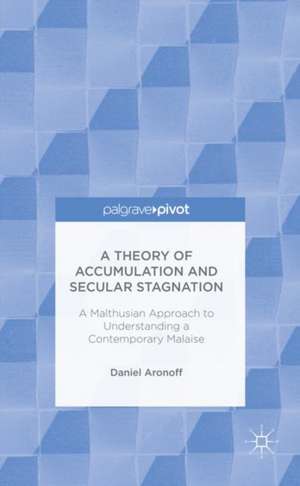A Theory of Accumulation and Secular Stagnation
Autor Daniel Aronoffen Limba Engleză Hardback – 9 dec 2015
In A Theory of Accumulation and Secular Stagnation, Aronoff explores Malthus' ideas relating to secular stagnation and uses the insight gained to understand the origins of the subpar growth and tepid employment, periodically punctuated by booms, that has plagued the US economy since the turn of the millennium. He explains how the rise of mercantilism among Asian countries – principally China – and increased income concentration generated an upsurge in excess saving. This accumulation created a chronic deficiency in demand while also depressing interest rates, which generated a search for yield that fuelled periodic booms.
Preț: 384.70 lei
Nou
Puncte Express: 577
Preț estimativ în valută:
73.62€ • 79.94$ • 61.84£
73.62€ • 79.94$ • 61.84£
Carte tipărită la comandă
Livrare economică 23 aprilie-07 mai
Preluare comenzi: 021 569.72.76
Specificații
ISBN-13: 9781137562203
ISBN-10: 113756220X
Pagini: 144
Ilustrații: VIII, 136 p.
Dimensiuni: 140 x 216 x 13 mm
Greutate: 0.34 kg
Ediția:1st ed. 2016
Editura: Palgrave Macmillan US
Colecția Palgrave Pivot
Locul publicării:New York, United States
ISBN-10: 113756220X
Pagini: 144
Ilustrații: VIII, 136 p.
Dimensiuni: 140 x 216 x 13 mm
Greutate: 0.34 kg
Ediția:1st ed. 2016
Editura: Palgrave Macmillan US
Colecția Palgrave Pivot
Locul publicării:New York, United States
Cuprins
1. Preface PART I: THE MALTHUS-RICARDO DEBATE 2. The Malthus-Ricardo Debate on General Glut and Secular Stagnation 3. Say's Principle and the Possibility of Deficient Demand PART II: ACCUMULATION AND SECULAR STAGNATION IN THE CONTEMPORARY UNITED STATES 4. The Theory of Accumulation and Secular Stagnation 5. Accumulation and Secular Stagnation in the US After the Turn of the Millennium 6. A Few Concluding Thoughts
Recenzii
“In A Theory of Accumulation and Secular Stagnation … Daniel Aronoff intelligently looks back to the works of early 19th-century ‘classical growth’ economist Thomas Malthus. … Aronoff does a laudable job of showing how Malthus’s theories might apply to the current economic environment. … as investors continue to evaluate potential implications for zero and negative interest rates, weak capital spending, and deflationary pressure, they will find it useful to include Malthus’s theory of accumulation as part of their mental models.” (Todd Wenning, CFA Institute, cfapubs.org, Vol. 11 (1), 2016)
Notă biografică
Daniel Aronoff is President of Landon Companies, USA. He has served as Vice Chairman of the Board of Trustees of Grand Valley State University, USA. Throughout several decades of participation in the professional world, Aronoff has been a frequent contributor to many media outlets including the Financial Times.
Textul de pe ultima copertă
Thomas Malthus identified a crucial tension at the heart of a market economy: While an accumulation of wealth is necessary to provide the capital investment needed to generate growth, too much accumulation will cause planned saving to exceed profitable investment, which will result in secular stagnation, a condition of low growth and underemployment of resources. Keynes drew inspiration from Malthus in his attempt to comprehend the causes of the Great Depression of the 1930s. Now, Aronoff demonstrates how a related but slightly different aspect of Malthus' thought can illuminate one of the most pressing issues of our times.
In A Theory of Accumulation and Secular Stagnation, Aronoff explores Malthus' ideas relating to secular stagnation and uses the insight gained to understand the origins of the subpar growth and tepid employment, periodically punctuated by booms, that has plagued the US economy since the turn of the millennium. He explains how the rise of mercantilism among Asian countries – principally China – and increased income concentration generated an upsurge in excess saving. This accumulation created a chronic deficiency in demand while also depressing interest rates, which generated a search for yield that fuelled periodic booms.
In A Theory of Accumulation and Secular Stagnation, Aronoff explores Malthus' ideas relating to secular stagnation and uses the insight gained to understand the origins of the subpar growth and tepid employment, periodically punctuated by booms, that has plagued the US economy since the turn of the millennium. He explains how the rise of mercantilism among Asian countries – principally China – and increased income concentration generated an upsurge in excess saving. This accumulation created a chronic deficiency in demand while also depressing interest rates, which generated a search for yield that fuelled periodic booms.
